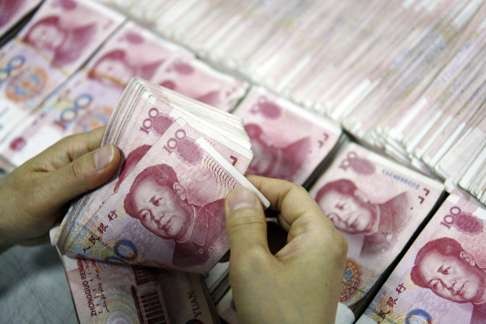Chinese corporate debt to peak by the end of 2016, analysts say
Country’s trade settlement structure also makes it too early to de-peg from the US dollar, they suggest

Corporate debt levels will peak in China by the end of this year, according to analysts.
But as China’s debt structure and trade settlement remains heavily denominated in US dollars, it is still too early for the country to give up the dollar peg, for a basket reference, they said.
China’s corporate credit-to-gross domestic product (GDP) ratio was 178 per cent in the first half of 2016, the highest in the G20, raising investor concerns about the nation’s financial stability, said Jason Sun, chief China strategist with Citi Research in Hong Kong.
“However, we see three early signs of corporate leverage peaking,” he added, citing the slowdown in the growth of new bank loans to corporates, slower credit growth in the industrial sector, and in companies traced by CSI300 Index and the MSCI China index.
“In previous cycles, China’s corporate credit-to-GDP ratio declined or stopped rising when new bank loans recorded negative growth, as in 2007, and 2010 to 2011,” Sun said.
Tomas Gatley, a senior analyst covering China’s corporate universe with Gavekal Dragonomics, shared some of Sun’s optimism, saying Chinese companies are “becoming increasingly risk-averse, particularly since 2015”.
“An examination of corporate balance sheets shows that this rising leverage is being driven more by state banks’ determination to pump out credit, than by reckless company behaviour,” he wrote in a research note last Wednesday.
“In fact, companies are happy to borrow from banks since credit is cheap and easily available, but they are holding on to the cash, rather than using it to expand the business.
“This corporate cautiousness means that growth is likely to keep slowing,” he wrote, noting looser monetary policy is becoming less effective at stimulating demand for credit, at least outside of real estate.
It also means that misallocation of capital is declining, and that firms are actually building up their resources to deal with any short-term financial problems, he wrote.
New bank loans to corporates from January to May rose only 4 per cent on the previous year, slower than the current nominal GDP growth of 7 to 8 per cent, and the total social financing (TSF) growth of 12 to 13 per cent, Citi’s research found.
TSF is a tool invented by the Chinese government to measure debt taken on by non-state entities.
Sun said Citi’s calculation, however, using industrial sectors’ interests expenses, and the People’s Bank of China’s published quarterly average effective loan, suggests the industrial sectors’ debt growth year on year as of May was 9 per cent, and the debt scale is likely to be declining from the end of 2015.
“Most debt-heavy sectors like coal, steel and cement are facing significant overcapacity, suggesting little credit expansion demand for capacity increases,” he said.
But he also added, a potential risk that could reverse his outlook, is China’s determination and pace to cut overcapacity.

Last month David Lipton, deputy managing director of the International Monetary Fund, said that China’s corporate debt ratio was as high as 145 per cent, and rising fast.
“Corporate debt remains a serious — and growing — problem that must be addressed immediately, with a commitment to serious reforms,” said Lipton.
He also warned, that with the rapid increase in credit growth in 2015 and early 2016, and the continued high rates of investment, the problem was growing, posing a key fault line in the Chinese economy.
Wang Tao, an economist with UBS and her colleagues also raised a more thorny issue, that around 16.5 trillion yuan (HK$19.14 trillion) in shadow credit was “missing” from the government’s official TSF figure, while a significant proportion of the shadow credit had flowed into corporate bonds.
“The real problem with rapid shadow credit growth is that it may have clouded policy-makers’ understanding of “true” credit growth and leverage ratio, and more importantly, weakened the funding stability of debt and the government’s oversight and control on system liquidity,” they wrote in a research note on June 28.
Liu Ligang, chief China economist with Citi, said it was too early for the yuan to de-peg from the US dollar.
“If you look at China’s debt structure, it is pretty much US dollar denominated. Highly leveraged companies only look at the yuan-dollar rate,” Liu said.
“If you look at China’s trade at this point, despite the yuan’s internationalisation, (settlement) is dominated by the US dollar,” he added.
“At this time, the market is not yet ready for any sharp yuan-dollar volatilities… the onshore hedging market is not developed yet,” he said.